TI’s OMAP 5 processors will sport dual 2GHz ARM Cortex A-15 cores
Feb 7, 2011 — by LinuxDevices Staff — from the LinuxDevices Archive — 11 viewsTI (Texas Instruments) announced that in the second half of this year, it will begin sampling two OMAP5 processors based on ARM's Cortex-A15. The OMAP5430 and OMAP5432 will offer dual 2GHz cores, support for up to four cameras, HD video encode/decode in 2D or 3D, imaging up to 24 megapixels, and “PC-like” Internet browsing, the company says.
 TI's OMAP 5 devices are based on the Cortex-A15 core announced by ARM last year (see later in this story for background). According to TI, the 28nm-fabricated OMAP5430 and OMAP5432 will both include two Cortex-A15 MPCore processors, each capable of being clocked up to 2GHz.
TI's OMAP 5 devices are based on the Cortex-A15 core announced by ARM last year (see later in this story for background). According to TI, the 28nm-fabricated OMAP5430 and OMAP5432 will both include two Cortex-A15 MPCore processors, each capable of being clocked up to 2GHz.
In addition to the two Cortex-A15 cores, the OMAP 5 chips add individual, dedicated engines for video, imaging and vision, DSP, 3D graphics, 2D graphics, display, and security, says TI. The devices also include two ARM Cortex-M4 processors apiece, "for offloading real-time processing from the Cortex-A15 cores to improve low-level control and responsiveness of mobile devices," the company adds.
The OMAP5430 and OMAP5432 are touted as providing "PC-like computing performance," but in fact appear to go beyond what's expected of most desktops today. For example, TI claims both OMAP 5 chips can support multiple cameras in parallel, recording and playing back either 1080p60 video in 2D or 1080p30 video in stereoscopic 3D. The devices also do real-time conversion of 2D 1080p content to 3D, says the company.
TI adds that the OMAP 5 chips will support advanced short- and long-range gesturing applications, as well as full-body and multi-body interactive gestures, utilizing either 2D or S3D cameras. Coupled with a TI DLP pico projector and a camera, they'll enable interactive projection, wherein the user can actually "touch and drag" projected images on both a tabletop or wall.
While specific power consumption figures weren't released, TI says the OMAP 5 processors will "provide a nearly 60 percent average power reduction compared to a sample user experience on the OMAP 4 [link] platform." Compared to these earlier Cortex-A9 devices, the OMAP 5 devices will deliver up to three times the processing performance and five times the 3D graphics performance.
Differences between the OMAP5430 and OMAP5432 ports are detailed in the table below, but briefly: TI says the former is a smaller (14 x 14mm) device designed for smartphones, with support for LPDDR2 memory. The '30 supports up to four simultaneous displays and imaging up to 24 megapixels, the company adds.
The OMAP5432 is for "more cost-sensitive products," is a larger 17 x 17mm, and supports DDR3 memory, according to TI. The '32 supports three simultaneous displays, imaging up to 20 megapixels, and supports fewer peripherals than the '30, as the table indicates.
| OMAP5430 | OMAP5432 | |
| Target markets | area-sensitive (smartphones, tablets) | cost-sensitive (mobile computing, consumer) |
| Process node | 28 nanometer low-power process | |
| ARM Cortex-A15 clock speed (two) | up to 2 GHz | |
| 2D & 3D graphics | multi-core, hardware accelerated | |
| Video performance (2D) | 1080p60 multistandard | |
| Video performance (3D) | 1080p30 multistandard | |
| Imaging performance | Up to 24 MP (MIPI CSI-3+ 3x MIPI® CSI-2+ CPI interfaces) |
Up to 20MP (3x CSI-2+ CPI interfaces) |
| Memory support | 2 x LPDDR2 | 2 x DDR3/DDR3L |
| Peripheral support | UART (6x), HSIC (3x), SPI (4x), MIPI UniPort-M, MIPI LLI, HSI (2x) |
UART (5x), HSIC (2x), SPI (3x) |
| Package | 14mm x 14mm PoP 980 balls 0.4mm pitch (240-ball, 0.5mm PoP) I/F) |
17mm x 17mm BGA 754 balls 0.5mm pitch (w/depop) |
A comparison of the OMAP5430 and OMAP5432
Source: TI
According to TI, both the devices will allow for HDMI 1.4a outputs, MMC/SD slots, and USB 3.0 On-The-Go ports. They'll utilize Imagination Technologies Powervr SGX544 GPU (graphics processing unit) IP, which is said to provide full support for DirectX 9 Feature Level 3, desktop OpenGL 2.1, and other standards.
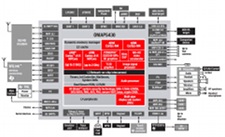
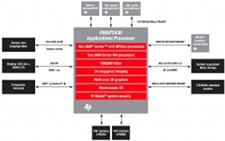
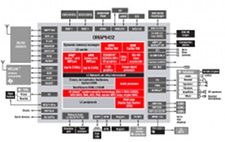
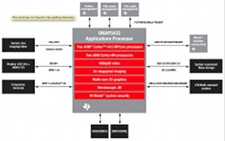
Chip (left) and application (right) block diagrams for the OMAP5430 (top row; chip (left) and application (right) block diagrams for the OMAP5432 (bottom row)
(Click any to enlarge)
Remi El-Ouazzane, vice president of TI's OMAP platform business unit, stated, "The bridge to true mobile computing enablement was missing until today. The OMAP 5 platform will be at the heart of driving the mobile computing revolution by delivering the highest computing, graphics and multimedia performance possible within the low power budget required by mobile form factors."
Mike Inglis, EVP and general manager of the ARM processor division, stated, "The OMAP 5 processor highlights the advantage of the ARM business model. The relationship enables product differentiation through the integration of low power multi-core ARM processor cores with the partners' own system-on-chip technologies, including power management, audio and video processing."
Background on ARM's Cortex-A15
Eager-beaver TI touted itself as "the first licensee of the next-generation ARM Cortex-A series processor core" even before the Cortex-A15 was formally announced. And certainly, there's a lot to like here.
For example, the Cortex-A15 MPCore processor is equipped with an out-of-order superscalar pipeline, along with a tightly-coupled low-latency level-2 cache of up to 4MB, according to ARM. The processor can decode and dispatch up to three instructions per cycle, says the company. This is said to be three times the rate possible with an ARM11 processor.
In addition, the Cortex-A15 can issue up to eight instructions per cycle, and take less than 10 microseconds to move into standby or wake up again. Floating point and NEON instruction set performance for signal processing and multimedia have also been improved, says ARM.
Compared to the Cortex-A9, the Cortex-A15 adds more efficient hardware support for operating system (OS) virtualization, soft-error recovery, larger memory addressability, and system coherency, says ARM. Large Physical Address Extensions (LPAE), shown in the diagram below, is said to permit addressing up to 1TB of memory.
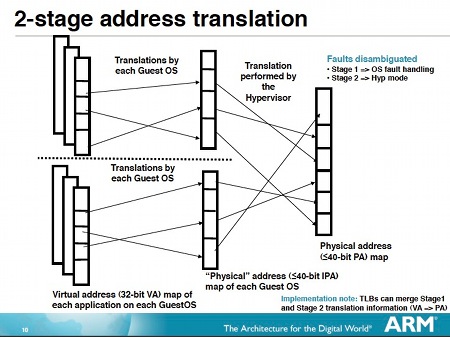
LPAE will let ARM Cortex-A15 CPUs work with physical memory up to 1TB
(Click to enlarge)
The Cortex-A15 is claimed to be the first ARM processor to incorporate highly efficient hardware support for data management and arbitration. This hypervisor support enables multiple virtual software environments and their applications to simultaneously access system capabilities while remaining isolated from each other, says the company. (For more details on some of the virtualization-oriented features in the ARMv7 extensions, see our earlier coverage here.)
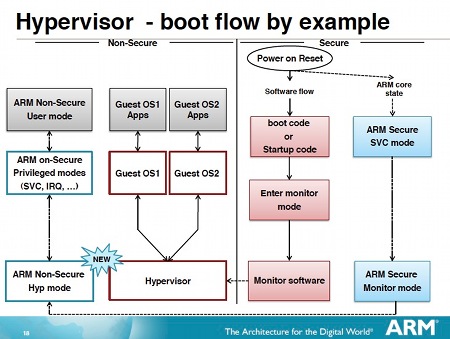
Hypervisor support available via ARMv7 extensions found in Cortex-A15
(Click to enlarge)
The Cortex-A15 is said to offer full application compatibility with all other Cortex-A processors, thereby enabling access to software including Android, Linux (including Ubuntu), Windows Embedded Compact 7, and Symbian operating systems. Compatibility is also claimed for Adobe Flash Player, Java Platform Standard Edition (Java SE), and JavaFX, among other applications.
TI did not detail all the software support it might be planning for the OMAP 5 devices. However, it did cite "comprehensive Linux open source software support" that will be "integrated and tested up to the application level, enabling faster and easier development."
Further information
According to TI, its OMAP 5 devices will sample during the second half of this year, with devices expected to go on the market during the second half of 2012. Further information may be found on the company's OMAP5430 product page and OMAP5432 product page.
This article was originally published on LinuxDevices.com and has been donated to the open source community by QuinStreet Inc. Please visit LinuxToday.com for up-to-date news and articles about Linux and open source.